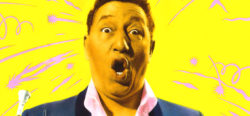The Sicilian Jazzman
Published: December 1, 2015
Last Updated: June 1, 2016
Louis Prima’s music developed in the nurturing atmosphere of New Orleans’ multicultural Tremé neighborhood
Music history by Bruce Raeburn
People who are not from New Orleans sometimes have difficulty understanding how identity works in certain neighborhoods, particularly when it comes to music and image. Take Louis Prima, for example, a Sicilian-American from Tremé, traditionally an African-American neighborhood. He was discovered in New Orleans playing at a little hole in the wall on Bourbon Street in 1934 by Guy Lombardo, of all people, who arranged a job for him at Leon and Eddie’s nightclub on 52nd Street in New York. A shot at the big time!
But when Louis showed up he was told that they couldn’t use him. The reason? The proprietor thought he was black because he was “swarthy” and — get this — “from New Orleans.” What Eddie Davis didn’t realize was that people from Tremé, let alone New Orleans, frequently exhibit cultural traits reflecting a lifestyle which transcends race in many ways. Whites, blacks, and all colors in between share ways of talking, eating, dancing, and making music that are unique to the neighborhood and the city. For somebody not from Tremé, that can really be confusing, especially if you’re a Yankee with some preconceptions about the South. So, Louis Prima lost that job, but he ended up going two doors down to The Famous Door, establishing himself as the hottest act on “The Street That Never Slept” and blowing the competition away. Come to find out, he’s the one who put Swing Street on the map. Moral of the story — Don’t mess wit’ Tremé, even if you’re from New York City.
Now, in retrospect, maybe we should forgive Eddie, because when you start investigating Louis Prima’s running partners in Tremé, you realize that he absorbed a lot from his African-American neighbors — jazz musicians like Henry Kid Rena and Lee Collins and Burnell Santiago (the “Creole King of Boogie Woogie Piano”) — who showed him a thing or two about music. What’s more, Creole musicians Harold Dejan and Mike Delay used to follow Louis’s gigs. You know he had something goin’ on if they were interested in him — and that was before he became famous.
Louis Prima became a star of stage and screen before World War II, but his musical accomplishments were about more than “making it” in the traditional showbiz sense. Besides putting a New Orleans kick in the Swing Era with songs like “Sing, Sing, Sing” — Prima wrote it, Benny Goodman cashed in on it — he was the first American entertainer to promote his Italian ethnic identity as something positive, a badge of honor (despite wartime suspicions). He contradicted anybody who thought that being an Italian-American was a handicap.
With recordings of “Felicia No Capicia,” “Baciagaloop (makes love on de stoop),” “Angelina,” “Oh Marie,” “Zooma Zooma,” and the ever popular “Please No Squeeza da Banana” (officer, unhand that fruit!), Prima demonstrated that music and humor belonged together, just like red beans and spaghetti. Let me rephrase that — just like red beans and rice. Whatever he did, Louis Prima made sure he had fun doing it, as did Louis Armstrong, to whom he is often compared. But that’s not imitation — joy is a New Orleans birthright.
Of course, today everyone knows about Louis Prima because we’ve had some pretty intensive refresher courses of late. If you own a television, you’ve heard his music and personality represented on commercials pushing Levi’s khakis, spaghetti sauce, Italian restaurants, you name it. And if you saw Disney’s The Jungle Book in re-release — or if you’re as old as I am and you know that he was the voice of King Louie — the orangutan King of the Jungle is a character based on Prima’s persona and not the other way around.
Prima is the only 20th-century show business personality to have gone from traditional jazz through rock-and-roll without ever slowing down to check the fashion pages for pointers. Long before Mick Jagger did it, he was rocking into his 50s. His exuberant and often infantile mugging in the face of Keely Smith’s impervious deadpan in the 1950s made him a household name, from the Rat Pack in Las Vegas to Middle-American families tuning in to the Ed Sullivan Show. That covers a lot of ground, what you call broad appeal — which may help explain why Prima was married five times.
Louis Prima today remains an American original, a timeless musical personality whose creativity, vitality, and humor are susceptible to endless rediscovery by generations of Americans to come. But we also need to remember that much of what people find interesting or humorous or profound about him derives from the culture in which he was nurtured, where African Americans, Sicilians, Hispanics, Native Americans, French, and so many other ethnicities blended into a world that somehow seems obvious and inscrutable at the same time. Reality in New Orleans consists of layers, like the multiple patches on a Mardi Gras Indian suit or the veils of a striptease artist, all of which qualifies as masking. How far do you want to go? Fact is, Carnival season don’t come nearly close enough to wearin’ out our penchant for trying on new identities, so an oasis like Saint Joseph’s Day is needed to resuscitate the spirit if we’re gonna survive Lent. It should come as no surprise that a celebration of the patron saint of Sicily is regarded as a good time to mask Indian, too, ‘cause when it comes right down to it, our needs are the same. And whatever it takes to satisfy ‘em — well, that’s what we’re gonna do.
———-
Bruce Raeburn, Ph.D., is director of the Hogan Jazz Archive at Tulane University.
